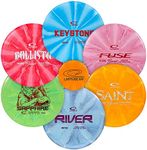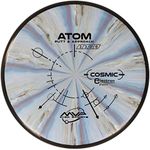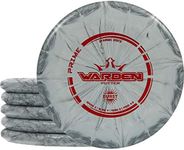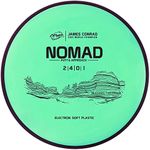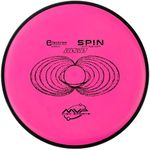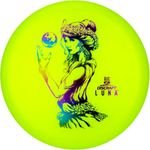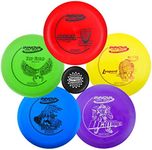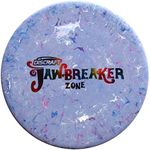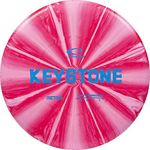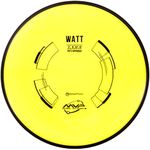Buying Guide for the Best Disc Golf Putters
Choosing the right disc golf putter can significantly impact your game. Putters are designed for short-range throws and are crucial for making those final, precise shots into the basket. When selecting a putter, it's important to consider various specifications that can affect your performance. Understanding these specs will help you find a putter that matches your playing style and needs.Plastic TypeThe plastic type of a putter affects its grip, durability, and feel. Softer plastics provide better grip and are more flexible, making them ideal for cold or wet conditions. Harder plastics are more durable and provide a consistent release but may be slippery in certain conditions. Choose a plastic type that feels comfortable in your hand and suits the weather conditions you typically play in.
WeightThe weight of a putter can influence its flight and control. Lighter putters (around 150-170 grams) are easier to throw and can provide more glide, making them suitable for beginners or players with less arm strength. Heavier putters (170-175 grams) offer more stability and control, which can be beneficial for experienced players who need precision. Consider your skill level and throwing strength when selecting the weight of your putter.
StabilityStability refers to how a putter flies in the air. Understable putters tend to turn right (for right-handed backhand throws) and are easier to control for beginners. Stable putters fly straight and are versatile for various shots. Overstable putters turn left and are more predictable in windy conditions, making them suitable for advanced players. Choose a stability level that matches your throwing style and the typical conditions you play in.
GripThe grip of a putter is determined by its rim design and the texture of the plastic. A comfortable grip is essential for consistent and accurate putting. Some putters have a bead (a small ridge around the rim) which can provide extra grip and stability, while others have a beadless design for a smoother feel. Try different grip styles to see which one feels most comfortable and secure in your hand.
SpeedSpeed is a rating that indicates how fast a putter needs to be thrown to achieve its intended flight. Putters typically have lower speed ratings (1-3) because they are designed for short, controlled throws. A lower speed rating means the disc is easier to control and less likely to overshoot the target. Choose a putter with a speed rating that matches your throwing power and the distance you need to cover.
GlideGlide measures how well a putter stays in the air. Higher glide ratings (4-6) mean the disc can stay aloft longer, which is useful for longer putts or approaches. Lower glide ratings (1-3) provide more control and are better for short, precise shots. Consider how much distance you need from your putter and how much control you require when selecting a glide rating.
